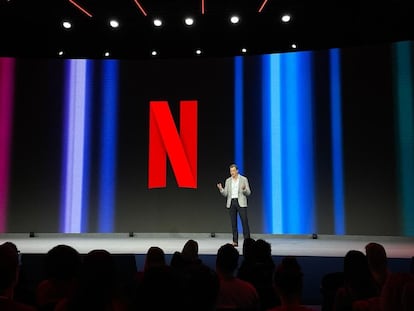Telcos gear up for the generative AI juggernaut
Telecommunications companies aim to be more than just intermediaries for the likes of ChatGPT, Google Gemini and Dall-E

The innovative technology powering ChatGPT, Google Gemini, and numerous comparable applications is projected to fuel a market worth $1.3 trillion by 2032. This technology, known as generative artificial intelligence, generated $40 billion in 2022 and is poised for an impressive annual growth rate of 41%, as reported by Bloomberg Intelligence.
AI service providers like OpenAI, Google and Microsoft are poised to reap the economic benefits of the AI tsunami by offering products to consumers and businesses. But they need telecommunication services for their distribution networks, and these services want a piece of the pie. Entire business models have been transformed with the rise of video on demand, social media and mobile apps. Will artificial intelligence produce the same paradigm shift?
The rise in generative AI usage will probably lead to much more network traffic. According to a study of the telecom sector by the IDC consulting firm, traffic volume is expected to surge, significantly impacting infrastructure capacity and latency. Why? Because a ChatGPT query requires more bandwidth than a Google search.
Service providers haven’t detected any unusual spikes yet. “Data traffic on our networks has consistently grown for over a decade, increasing by 30% annually,” said Bernard Despres, a vice president with Orange, the French multinational telecommunications company. “Managing higher volume is not hard, but it gets trickier with diverse data types,” he said, referring to the variety of traffic generated by different services and applications.
Julia Velasco from Vodafone Spain acknowledges that traffic was increasing significantly even before the use of generative artificial intelligence. “When considering use cases for rapid development with generative AI, image processing and generation play a crucial role. Will this inevitably boost network traffic? I believe it will,” she said. One example she mentioned was identifying security threats in camera images, causing localized traffic spikes.
Profiting from AI services
Telecoms want to share in the revenue of major platforms like Netflix, Google, Spotify and WhatsApp, arguing that their significant infrastructure investments justify this.
To maximize revenue from their networks, telecom service providers worldwide launched the Open Gateway initiative, which standardizes programming tools and APIs, enabling applications to access specific network capabilities. Initially intended for services like video on demand, this approach can also be used with generative AI tools.
“An app could enhance its service or add value by using network features that the user can turn on or off. This could be done through APIs,” said Velasco. “If your generative AI solution improves with more capacity, companies like us can monetize our services more effectively.”
Currently, there are no specific APIs designed for generative AI services. However, Orange also thinks the Open Gateway framework could enable telcos to generate income from application developers. “Thanks to 5G technology, we have highly advanced capabilities, such as very low latency, high data transfer speeds and great reliability,” said Despres. “But we need to evolve further because applications will need individualized quality. And we can do this by giving app developers access to advanced 5G network capabilities through the Open Gateway initiative.”
Despres offers some examples of how these advanced capabilities could be used. “On Netflix, signal delays are acceptable because the focus is on providing high-quality video. But live streamers and broadcasters need real-time, instant updates during sports matches.” Open Gateway allows each application to utilize the network APIs that align best with its particular needs.
“As a telecom company, I can provide a product using generative AI or find ways to integrate into the value chain associated with this technology,” said Velasco. “Open Gateway enables us to explore a range of possibilities. We could provide developers of generative AI solutions to APIs for optimizing systems through the network offerings. Initiatives like Open Gateway will help us contribute to technological evolution instead of just being carriers.”
Most large telcos are already committed to Open Gateway. Spain’s Telefónica, one of the largest telcos in the world, notes that while they have no specific APIs for generative AI applications, they are leveraging the technology to improve their networks. Carolina García, head of AI at Telefónica, said, “We are creating chatbots or assistants to keep technicians informed about network status and guide them on problem resolution.”
In network operations, generative AI can help manage and even predict incidents and outages. “We’re also looking into using generative AI as a natural language interface to ask the network directly about ongoing events,” said García. Traditional artificial intelligence monitors the network, and a generative model is used to formulate queries about network status. Vodafone and Orange also have launched programs to use generative AI for resolving network issues.
Ultimately, telcos don’t want to just be passive intermediaries or carriers for the generative AI boom, and are gearing up to reverse its stagnant fortunes. McKinsey estimates generative AI could bring in $140-180 billion in annual revenue for the telecommunications industry.
Sign up for our weekly newsletter to get more English-language news coverage from EL PAÍS USA Edition
Tu suscripción se está usando en otro dispositivo
¿Quieres añadir otro usuario a tu suscripción?
Si continúas leyendo en este dispositivo, no se podrá leer en el otro.
FlechaTu suscripción se está usando en otro dispositivo y solo puedes acceder a EL PAÍS desde un dispositivo a la vez.
Si quieres compartir tu cuenta, cambia tu suscripción a la modalidad Premium, así podrás añadir otro usuario. Cada uno accederá con su propia cuenta de email, lo que os permitirá personalizar vuestra experiencia en EL PAÍS.
¿Tienes una suscripción de empresa? Accede aquí para contratar más cuentas.
En el caso de no saber quién está usando tu cuenta, te recomendamos cambiar tu contraseña aquí.
Si decides continuar compartiendo tu cuenta, este mensaje se mostrará en tu dispositivo y en el de la otra persona que está usando tu cuenta de forma indefinida, afectando a tu experiencia de lectura. Puedes consultar aquí los términos y condiciones de la suscripción digital.










































